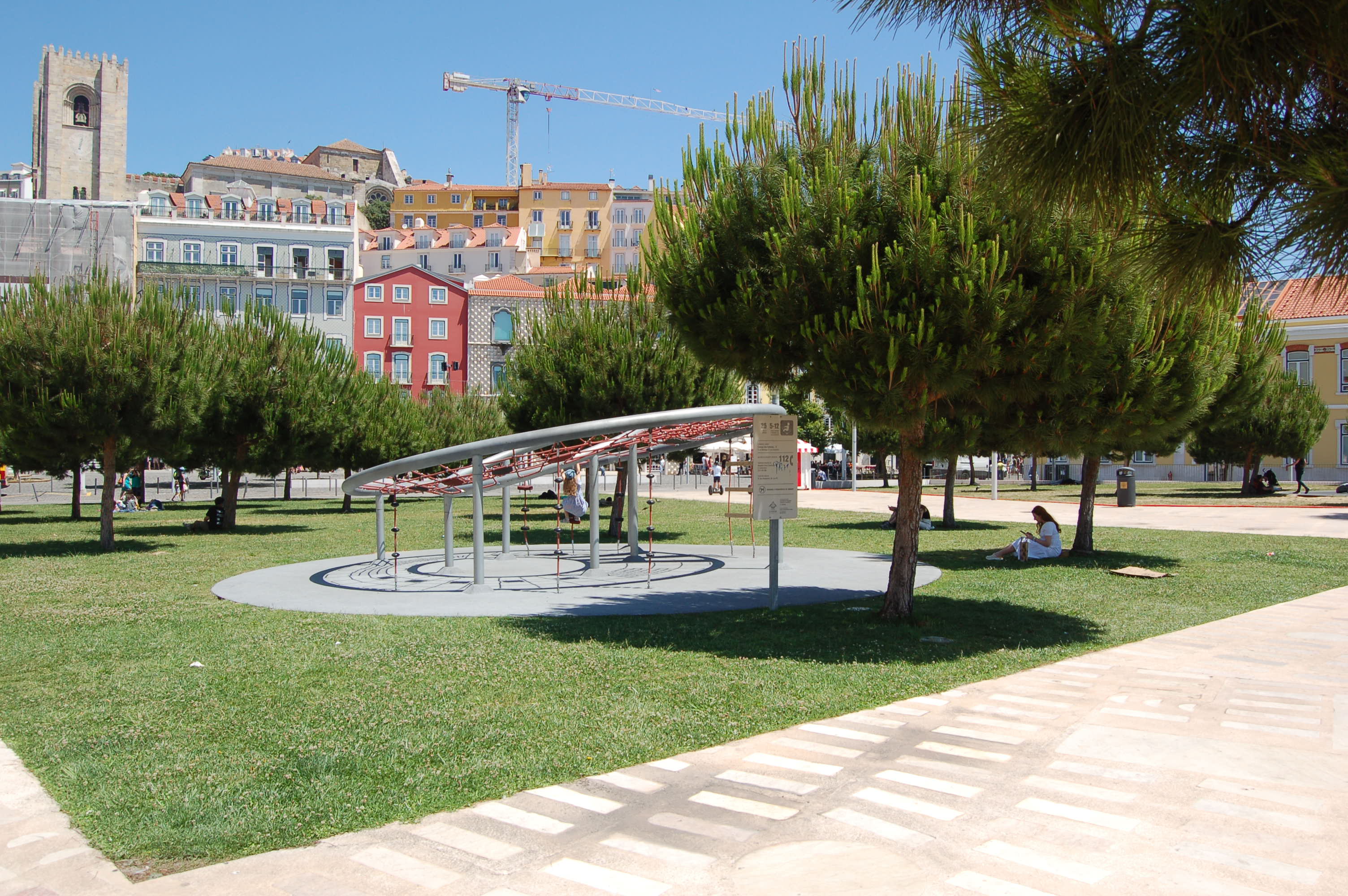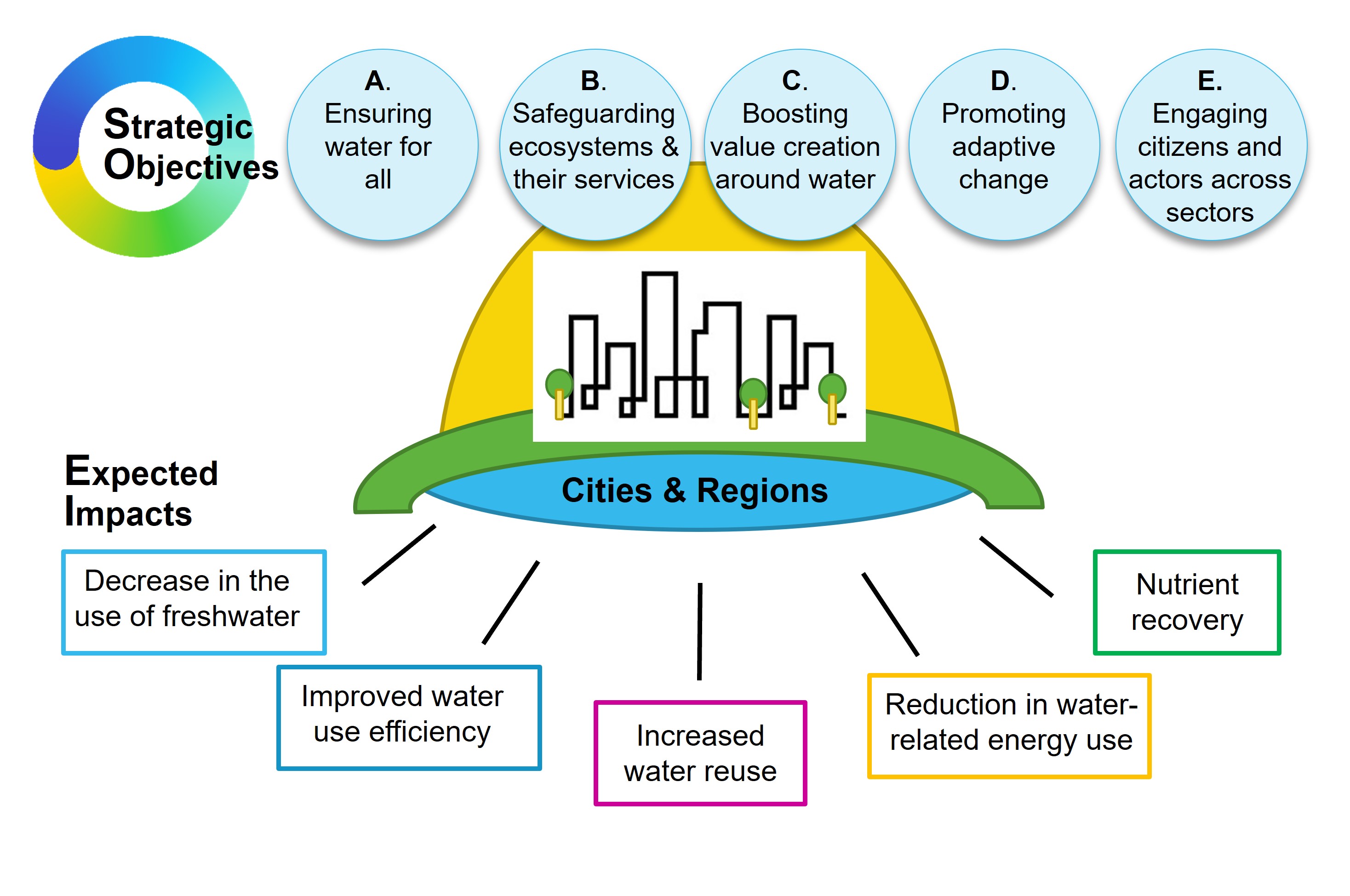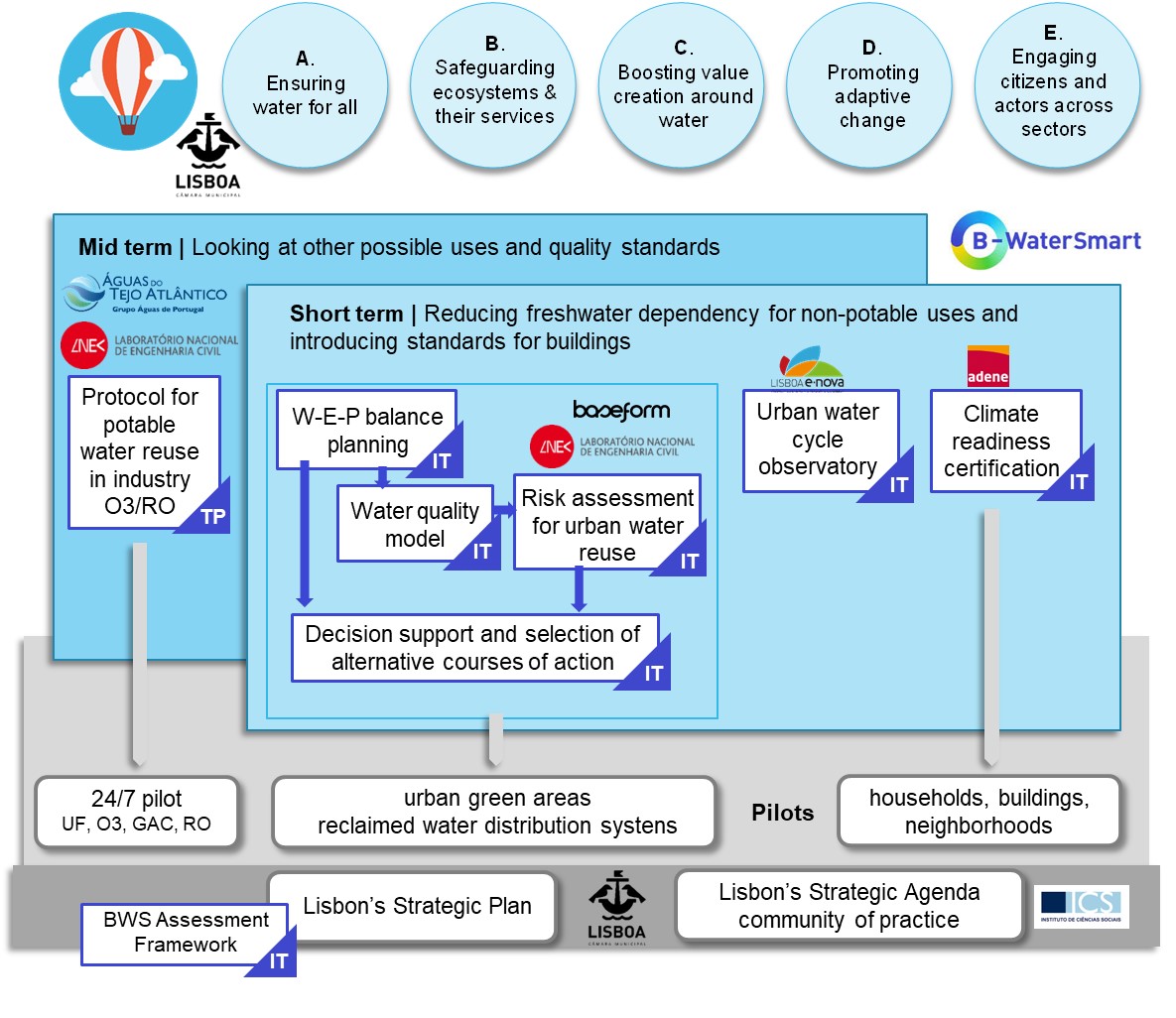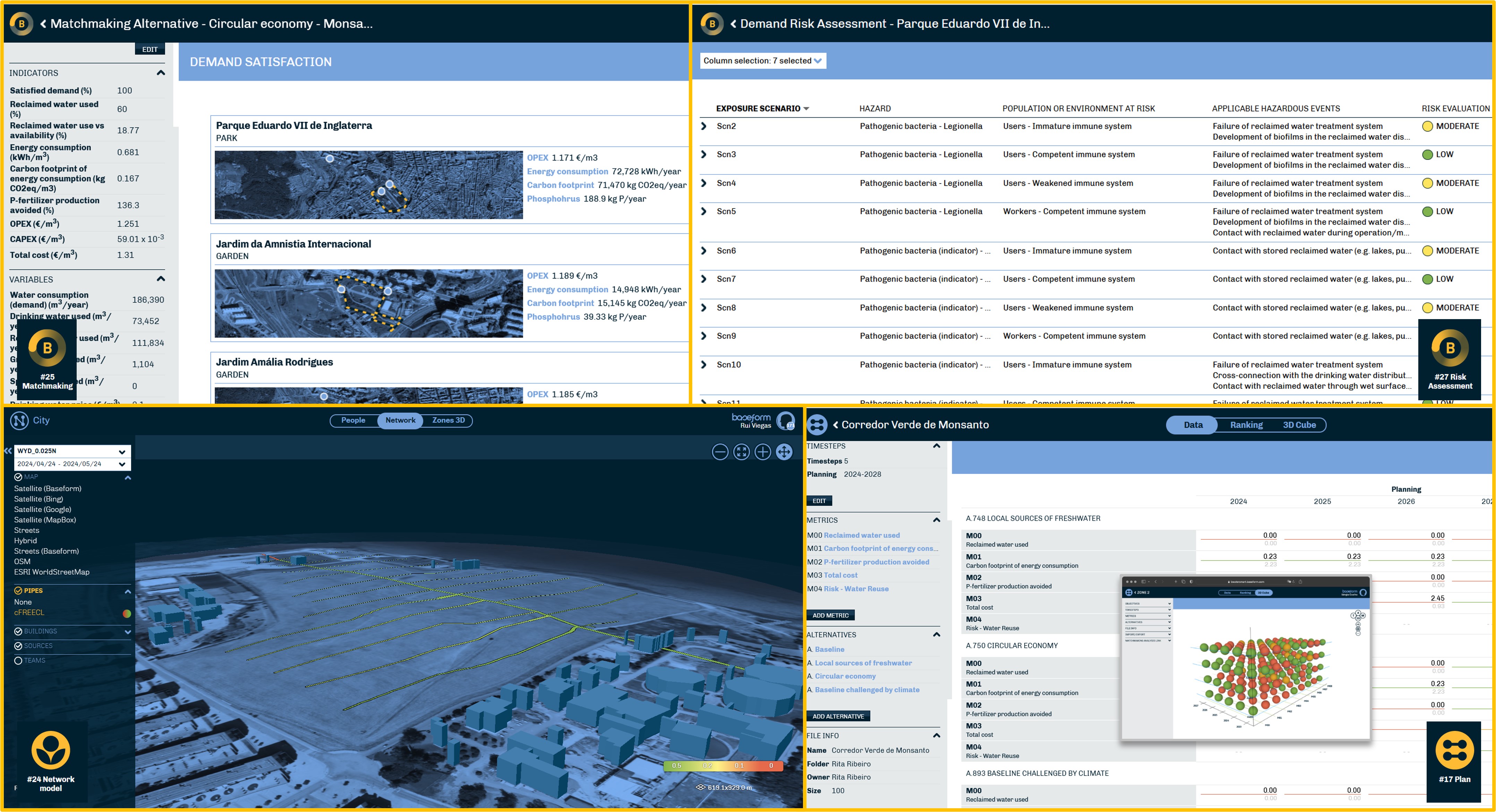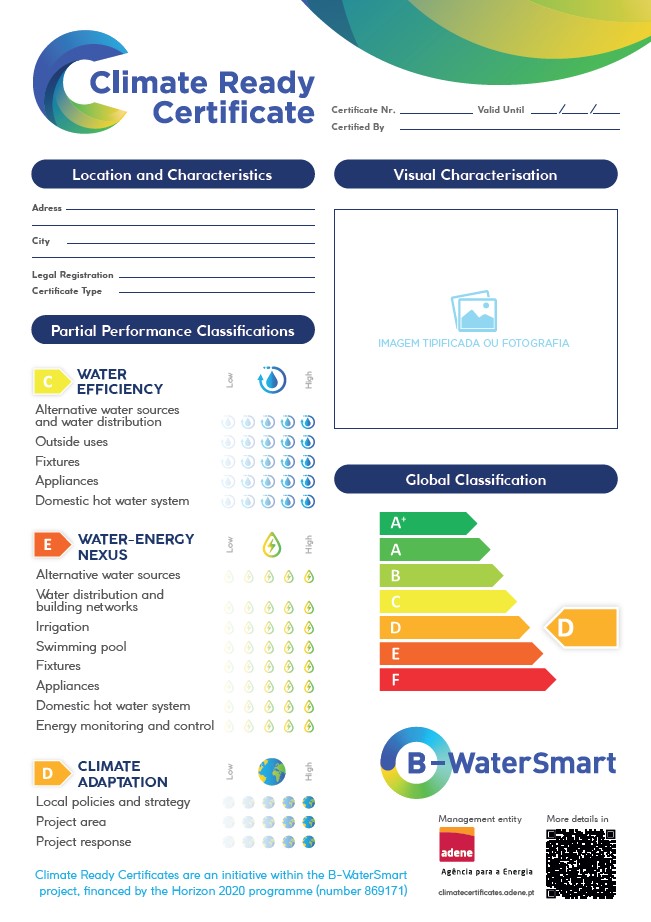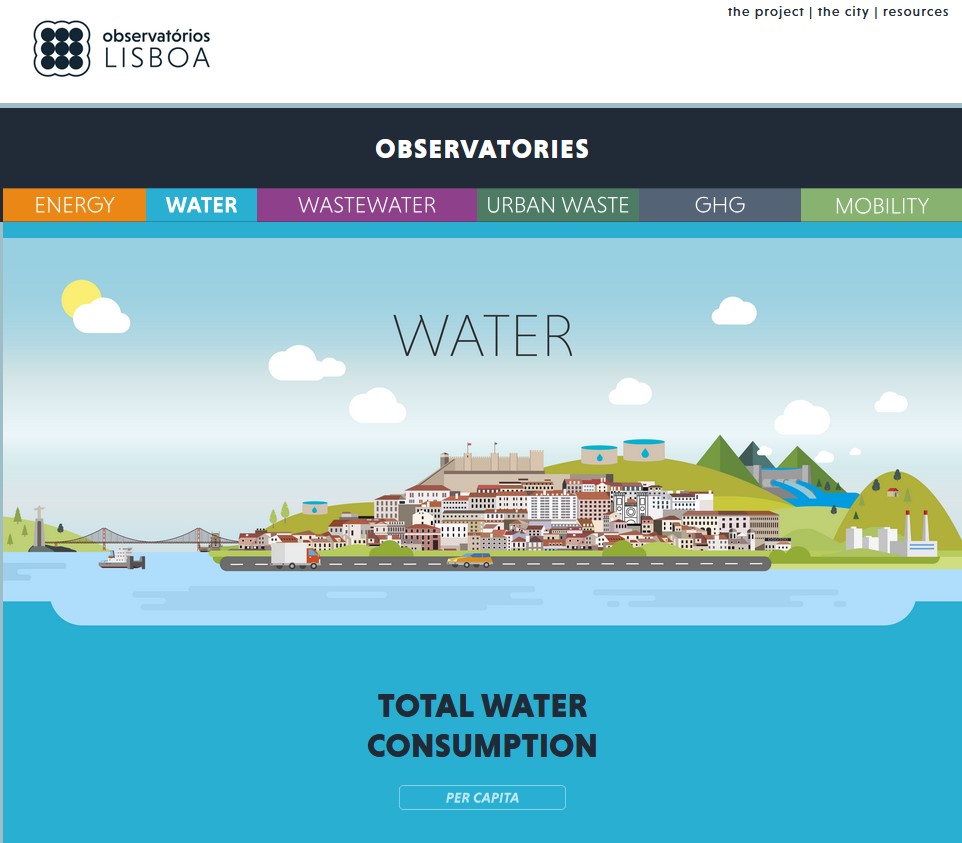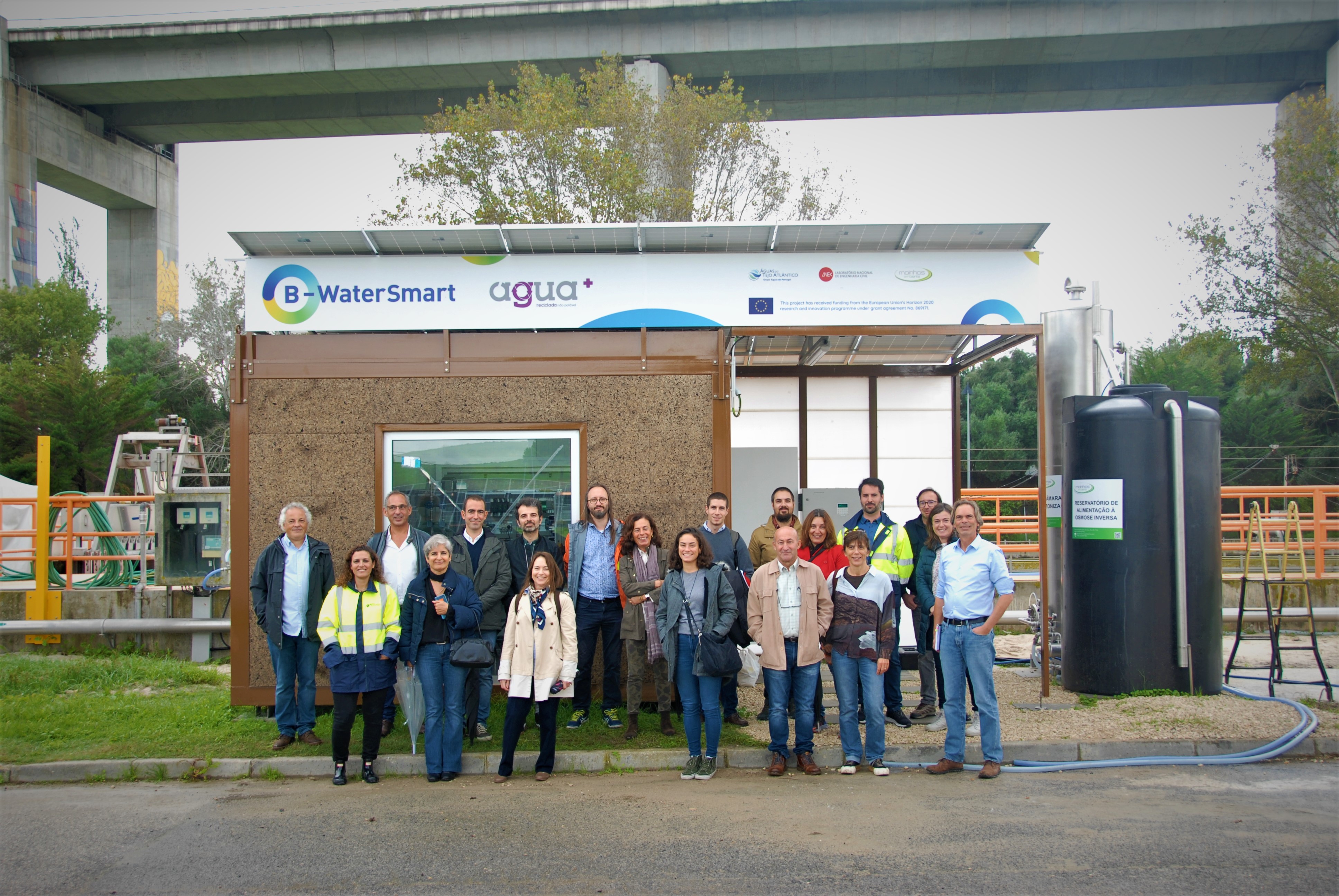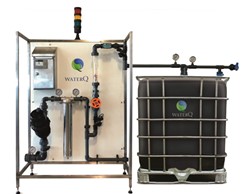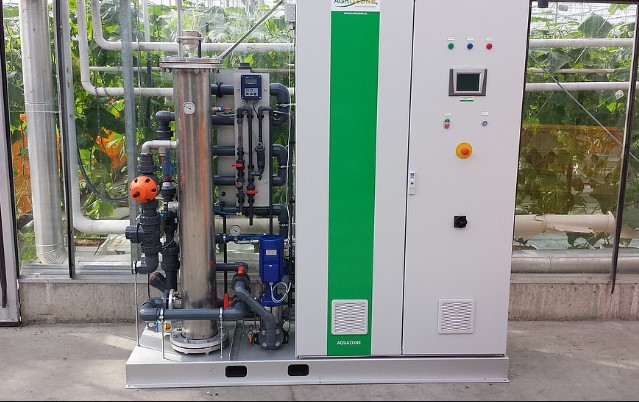Description
Like many European regions and cities, Lisbon, the capital city of Portugal, faces water challenges related to (i) increased population concentration and a growing economy, (ii) the effects of climate change (heat waves, heat islands, droughts), (iii) the need to expand urban green areas, as a green-blue problem-solving infrastructure to ensure citizens’ quality of life and the sustainability of urban living, and (iv) the need to reduce the current use of drinking water for non-potable municipal water uses.
The Lisbon Living Lab (Lisbon LL) addressed these challenges by focusing its action on smart urban water allocation (i.e., fit-for-purpose), safe reuse and efficiency at the municipal level. The key drivers were to (i) reduce dependence on freshwater and eliminate the use of drinking water for municipal non-potable uses, (ii) introduce standards for buildings, and (iii) prepare for potable reuse to anticipate increased water scarcity while building trust and acceptance on this alternative water source for current non-potable uses in Lisbon and beyond.
Within the B-WaterSmart project, the Lisbon LL deployed the following innovations:
- a smart-water allocation four tool set, which implements an integrated approach for selecting and prioritising [environment for decision support digital tool] the alternatives that best meet the current and planned/forecasted demand for water (in quantity and quality) in a city or region, in terms of technical, environmental and economic performance [balance planning digital tool] and safety [risk assessment digital tool and water quality modelling digital tool, for assessing and managing the risk associated with water reuse];
- a climate-readiness certification scheme for buildings [one digital tool];
- an urban water cycle observatory, for informing and engaging stakeholders & society [one digital tool];
- a protocol for direct potable reuse in craft beer industry, based on a pilot demo of advanced treatment technology.
The Environment for Decision Support and Selection of Alternative Courses of Action is a numerical and visual decisional environment that enables non-experts to easily comprehend the decisional problem around water-smart allocation for urban non-potable uses. This tool implements a curated set of specifically designed metrics for the strategic and tactical prioritization of regional or urban supply/demand solutions involving potable and non-potable water. It is tailored to the decisional problem laid out by the water-energy-phosphorus (W-E-P) balance planning module, which produces candidate supply/demand combinations. This tool goes beyond the state-of-the-art because it provides a strategic and tactical prioritization environment specific to the planning of urban non-potable water uses with a focus on water reuse..
The Water-Energy-Phosphorus Balance Planning Module implements a matchmaking framework for enabling a smart combination of the water sources and water demand points existing or planned in a city or region. This matching tool allows the design of supply solutions to a set of potential users of non-potable water. The resulting alternative combinations are further evaluated (risk, in case of water reuse) and then ranked within the smart water allocation tool set. This planning module goes beyond the state-of-the-art as it provides a new and sound ability to match water supply to demand, while managing water volume, energy, phosphorus, cost, and risk.
The Risk Assessment for Urban Water Reuse Module module enables a clear and comprehensive risk assessment and treatment of urban non-potable water reuse. The framework operationalised by this tool for health and environmental risk assessment and management is mainly based on the relevant ISO standards, the Regulation (EU) 2020/741 on minimum requirements for water reuse and the groundwater’s DRASTIC vulnerability index. The novel scenario building process helps define how far to take the building of risk scenarios, a recurrent challenge for water reuse practitioners and regulators, and facilitates the validation of the risk management framework. The health risk assessment module of non-potable water reuse goes beyond the state-of-the-art as the framework includes (i) an additional step for establishing the context and (ii) a description of the activities from which the hazard exposure scenarios may be built (risk identification step). Other key innovation of this tool is the model of risk management structured around three primary components (decision-makers, data elements and respective links).
The Reclaimed Water Quality Model in the Distribution Network is a complete hydraulic and water quality extended-period simulation model for pressure flow networks. By modelling the (bulk and wall) decay of residual chlorine, the key barrier for water microbial stability, this tool delivers a solution to the problem of analysing and assessing the environmental and public health risks posed by using pipe networks for transporting and distributing reclaimed water. This tool goes beyond the state-of-the-art because it implements a newly developed mechanistic model comprising bulk and wall residual chlorine decay. This model also highlights the importance of ammonia for managing chlorine residuals in reclaimed water distribution systems.
The Climate Readiness Certification tool acts as a mechanism to incentivize, monitor and guide decision makers to adopt more sustainable practices in buildings. This is achieved by establishing clear and measurable criteria that are effective in reducing water and energy consumption and in improving climate change adaptation. By classifying the performance of a dwelling, building or neighbourhood, and also identifying strengths and areas for improvements, the tool provides tangible information on the improvement opportunities to make the buildings more resilient to climate change. This tool goes beyond the state-of-the-art since it offers a comprehensive solution, providing a certification that addresses water use in buildings in a holistic perspective, combining three dimensions, i.e. water efficiency, water-energy nexus and climate adaptation.
The Urban Water Cycle Observatory is a data visualization instrument for analysing and communicating data related to water consumption, wastewater treatment and reclaimed water production in the city of Lisbon, to support planning and decision making. This tool goes beyond the state-of-the-art by making available on a public platform the information respective to the water use (consumption and treatment) in the city. Because it is updated annually, citizens can be better informed on sustainability matters. It also makes available a private area of this platform to entities, such as the Lisbon Municipality, for them to have access to detailed information on water consumption data and data analysis results, to increase the water use efficiency on their installations.
A Protocol for Safe Potable Reuse in the Beverage Industry was developed to promote public confidence in the safety of water reuse. It was based on the results and lessons learned from a 24/7 pilot demo of different reclamation schemes including ultrafiltration, ozonation, biologically active carbon filtration and reverse osmosis. New data and knowledge were produced, both on the water quality requirements and on the reclamation technologies. The protocol includes (i) a discussion of the three key components (regulatory, technical, and public outreach) of direct potable reuse for craft beer production, and (ii) an analysis of the multi-barrier approach needed for safe direct potable reuse for craft beer production, the critical control points, and the monitoring.
Applied technologies
Facts of the applied technologies
UF (industrial scale) + pilot O3+BAC+RO. Pilot features:
- Capacity: 1.25 m3/h
- Water recovery rate: 70%
- Energy consumption (ozonation and reverse osmosis): 0.7 kWh/m3
- Energy self-sufficiency: ~60% with photovoltaic energy production
Key performance indicators
Water quality effectiveness KPIs [Protocol for safe potable reuse in the beverage industry]:
- Compliance with drinking water quality standards according to the EU (DIRECTIVE (EU) 2020/2184) and national legislation (Decree-Law No. 69/2023)
- Removal of pathogen indicators to absent
- Removal of PFAS to below LOQ
- Removal of disinfection by-product to below LOQ
- Removal of pharmaceutically active compounds to below LOQ
No prior situation existed as this is a new product (reclaimed water for craft beer production).
Best practices
A reclamation protocol for water reuse in craft beer production is presented in the B-WaterSmart public Deliverable 2.8.
Synergistic benefits
A set of 4 complementary digital tools was designed to support the decision-making process for a smarter water allocation and safe water reuse – an environment for selection of alternative sources of action tool fed by a W-E-P planning module tool and, in case of water reuse, by a health and environmental risk assessment tool and a reclaimed water quality distribution modelling tool, a key instrument for risk management.
The health and environmental risk assessment tool makes available expert knowledge for risk managers and stakeholders responsible for non-potable water uses, guiding them through the often-complex process of licensing urban water reuse projects. Hopefully, this standardized solution may facilitate urban management policies for achieving a full integration of reclaimed water into the urban water supply systems, i.e., increasing urban water resilience.
The work undertaken by B-WaterSmart formed the basis for establishing a Water-Oriented Living Lab in Lisbon, aligning with the criteria set forth by Water Europe and embraced by the Water4All European partnership. The Lisbon Water Smart Living Lab (Lisbon WOLL) was recently recognized in the “Atlas of EU water-oriented living labs” (2024).
Key lessons
The impact of the Lisbon LL solutions developed is granted by the tools as a coherent set of accelerators/facilitators of the transformation of Lisbon into a water smarter city, quantitatively measured by the BWS Assessment Framework tool. The tools contributed to the transition process feasibility as follows:
- Technical feasibility – by demonstrating direct potable reuse at pilot scale (technology: water reclamation protocol); by prioritizing strategic and tactical planning options on water management [digital tools: environment for decision support and W-E-P planning module]; by guiding risk managers and stakeholders responsible for non-potable water uses [digital tool: risk assessment module]; by mapping and managing risk in reclaimed water distribution networks [digital tool: reclaimed water quality model]; by promoting water and water-energy efficiency in buildings [digital tool: climate-readiness certification].
- Economic feasibility – by providing information for cost-benefit analysis of reclaimed water use, including phosphorus and energy [digital tools: decision support and W-E-P planning module] and direct potable reuse [technology: water reclamation protocol].
- Social acceptability – by building the trust on water reclamation and reuse, associated to a pleasant social activity, e.g. beer drink events – if water reclamation can be safe and reliable for the reclaimed water to be used in beer production, it should be easier to safely treat it for non-potable uses [technology: water reclamation protocol]; by providing an easy to understand and communicate risk assessment method [digital tool: risk assessment module]; by increasing the citizens’ awareness about the local context regarding the water use in the city and informing individual entities about their water consumption [digital tool: urban water cycle observatory].
Lessons learned from technology operation
- The practical implementation of new directives on drinking water and urban wastewater treatment will likely be hampered by the current limitations (LOQ, cost, time) of the commercial offer on micropollutant analysis.
- Undue salt intrusions to the drainage system have an impact on the RO-based water reclamation process and must therefore be controlled.
Legislation and policy recommendations
In the context of the Lisbon LL, particularly for water reuse, relevant legislation includes:
- European Regulation Reg. (EU) 741/2020 on minimum requirements for water reuse in agricultural irrigation
- Urban waste-water treatment Directive recast (under approval)
- Directive (EU) 2020/2184 on the quality of water intended for human consumption (recast)
- Portuguese Decree-Law 119/2019 on water reuse
Applied products
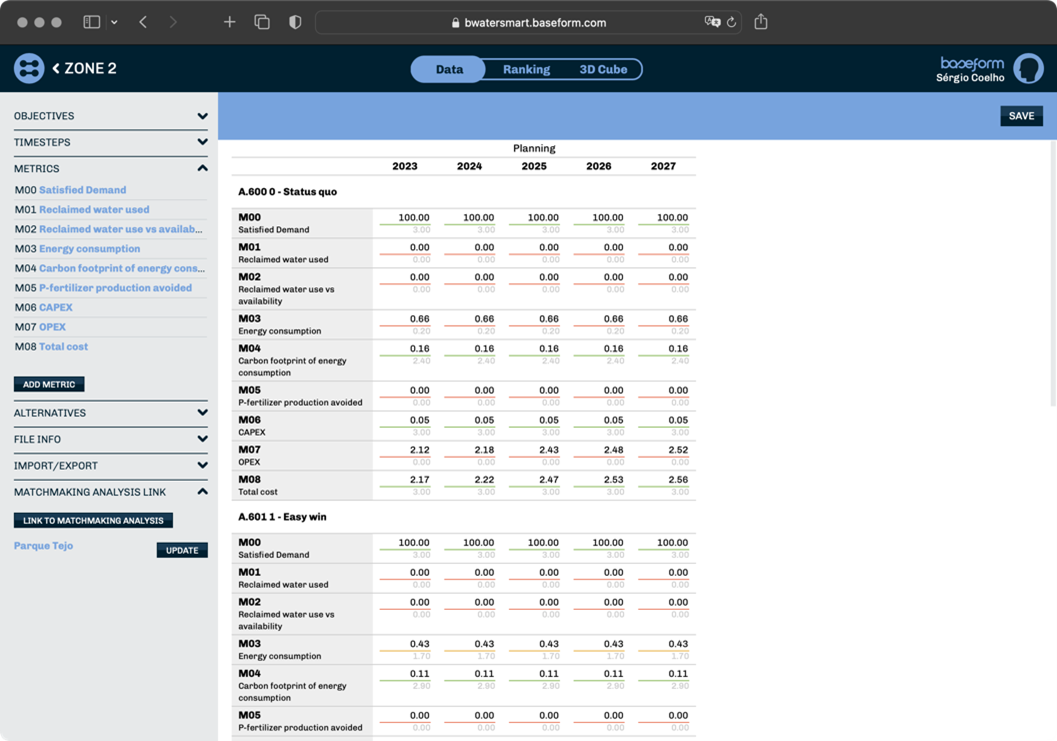
Environment for decision support and alternative course selection
A multi-criteria decision framework designed to allow for direct comparison of the supply/demand matchmaking alternativ…
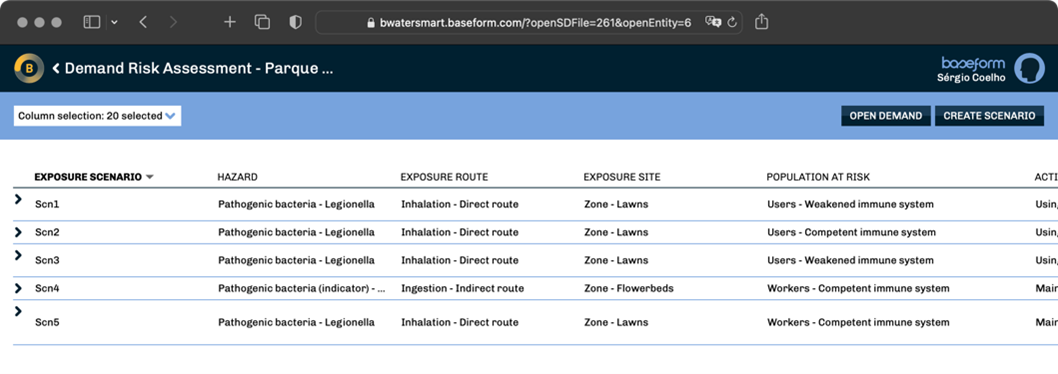
Risk Assessment for urban water reuse module
A human and environmental risk framework that assesses supply/demand combinations, based on a range of current risk sta…

Urban Water Cycle Observatory
The Urban Water Cycle Observatory is a data visualization instrument for monitor and communicate performance, support u…
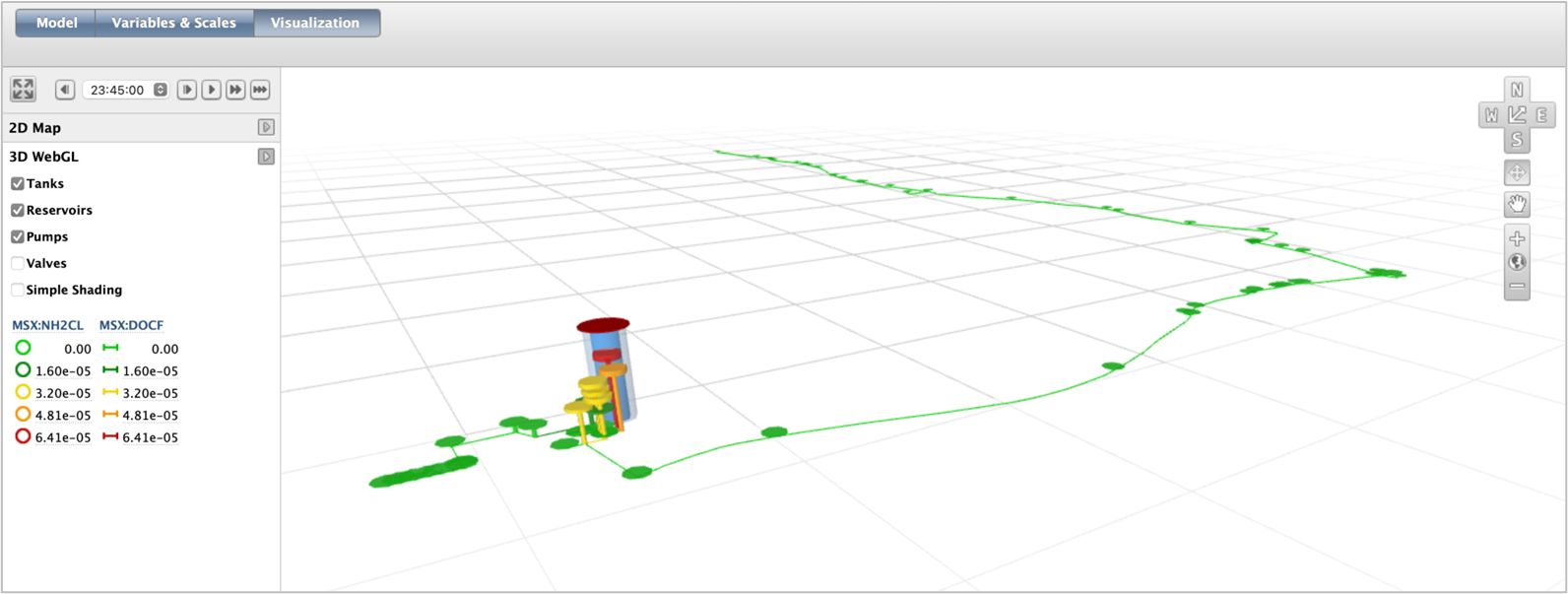
Reclaimed water distribution network water quality model
A complete hydraulic and water quality extended-period simulation model for pressure flow networks, designed to simulat…
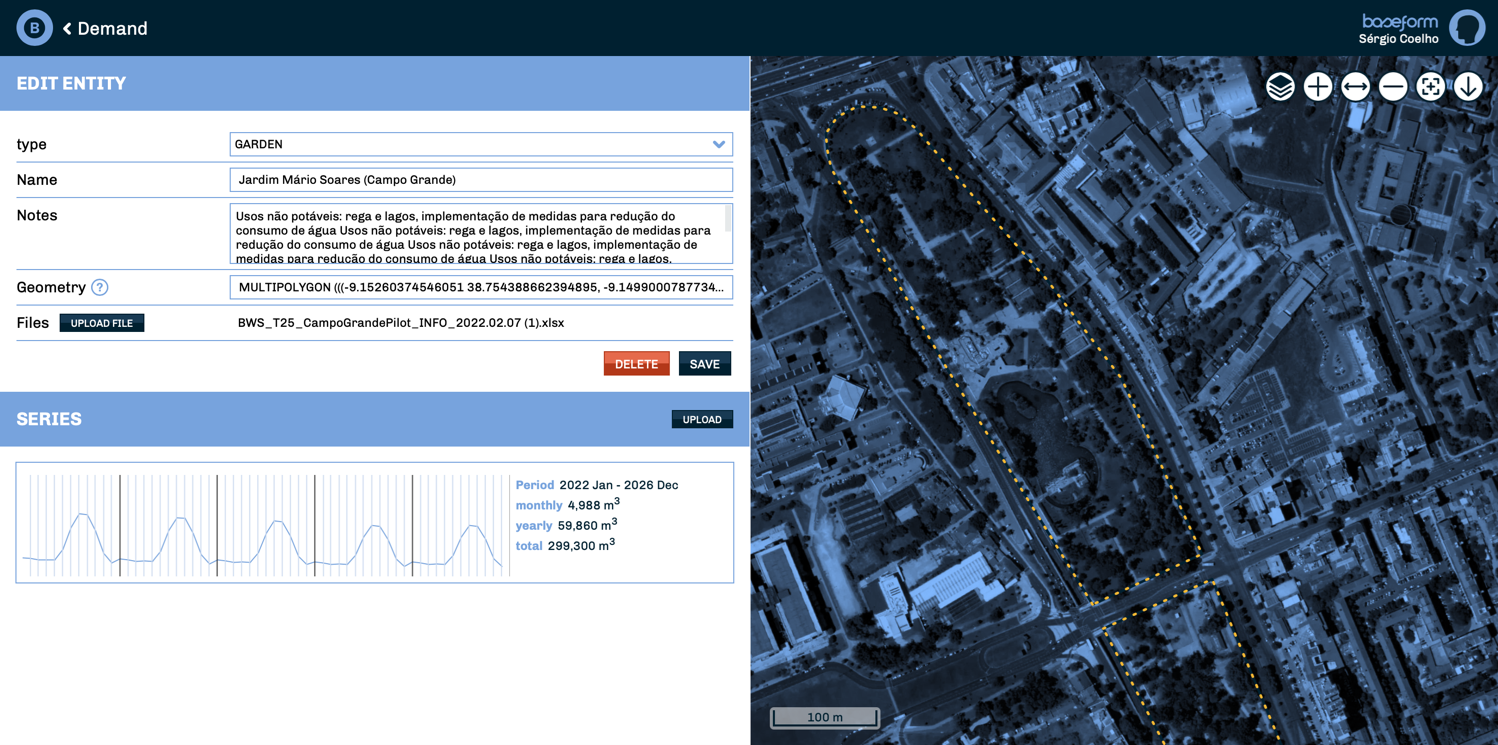
Water-energy-phosphorous balance planning module
This supply/demand matchmaking environment was conceived and designed entirely for B-WaterSmart, where sources and dema…
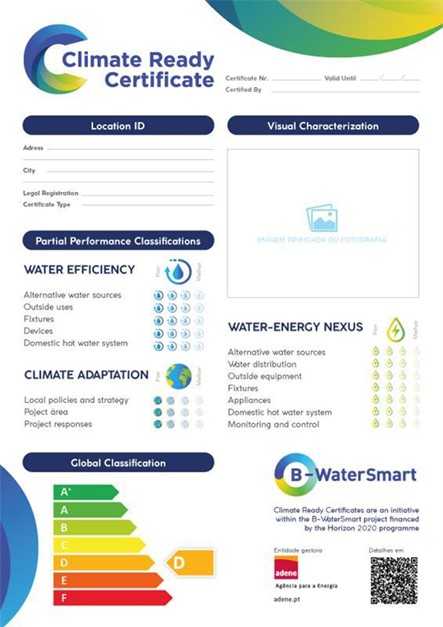
Climate Ready Certificates
Climate-readiness certification tool (CRC) is the online digital platform that calculates and emits the Climate-ready c…
Publications and references
- Rosa M.J., Ribeiro R., Viegas R., Oliveira M., Teixeira P., Figueiredo D., Lourinho R., Mendes R., Fernandes J., Alpalhão J., Coelho S.T., Vitorino D., Andrade D. (2024) B-WaterSmart solutions for Lisbon - Summary report. B-WaterSmart D2.15. August.
- Figueiredo D., Lourinho R., Viegas R.M.C., Mesquita E., Rosa M.J. (2024) A reclamation protocol for water reuse in craft beer production. B-WaterSmart D2.8. May.
- Costa, J., Mesquita, E., Ferreira, F., Rosa, M. J., and Viegas, R. M. (2021). Identification and modelling of chlorine decay mechanisms in reclaimed water containing ammonia. Sustainability, 13(24), 13548.
- Costa J., Ferreira F., Viegas R.M.C. (2022) Modelling chlorine decay in reclaimed water distribution systems. Águas e Resíduos iV.11.
- Costa J., Mesquita E., Ferreira F., Figueiredo D., Rosa M.J., Viegas R.M.C. (2023) Modeling Chlorine Decay in Reclaimed Water Distribution Systems—A Lisbon Area Case Study. Sustainability 15(23), 16211.
- Ribeiro R., Rosa M.J. (2024) The Role of Scenario-Building in Risk Assessment and Decision-Making on Urban Water Reuse. Water 2024, 16(18), 2674.
- Viegas R.M.C., Costa J., Mesquita E., Ferreira F., Rosa M.J. (2023) Mechanistic modelling of chlorine decay in reclaimed water containing ammonia. 13th IWA International Conference on Water Reclamation and Reuse, Chennai, India, 15-19 January (conference paper)
- Viegas R.M.C., Figueiredo D., Mesquita E., Charrua S., Costa C., Lourinho R., Rosa M.J. (2025) Pilot-scale studies of advanced wastewater treatment for direct potable water reuse for beer production. 14th IWA International Conference on Water Reclamation and Reuse, Cape Town, South Africa, 16-20 March (conference paper)
- Viegas R.M.C., Costa J., Mesquita E., Figueiredo D., Coelho S.T., Teixeira P., Rosa M.J. (2025) Mechanistic modelling of chlorine decay in reclaimed water distribution systems – case study applications. 14th IWA International Conference on Water Reclamation and Reuse, Cape Town, South Africa, 16-20 March (conference paper)

